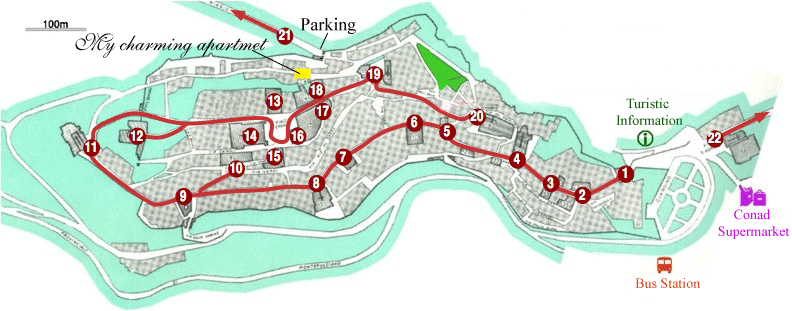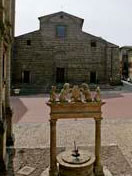- Porta al Prato: The Medieval Porta al Prato was transformed in 1511 by Sangallo the Elder and included in the new walls of the city wanted by the Grand Duke of Florence Cosimo de' Medici.
- Marzocco Column: That column symbolizes the authority of Florence since 1511 when the lion replaced the Siena's she-wolf.
- Bucelli Palace: The Palace was owned by an antique collector that walled in the façade Etruscan cinerary urns and stones with Etruscan and Roman inscriptions. On the opposite side is the Palazzo Cocconi Del Pecora, attributed to Sangallo the Elder.
- St. Augutin Church: The St. Augustin Church was built in 1285 and renovated in the 15th century by Michelozzo in a late Gothic/early Renaissance style. Situated on a staircase with a 18th century balustrade has a facade divided into four oorders. The two lower levels (1430-1440) are the work of the floentine Michelozzo, while the upper levels are from a later era. The internal has been rebuilt at the end of the 18th century but, above the main altar, still conserve a wooden Cricifix (1533), work of Antonio da Sangallo the Elder. In front of the St. Augustin Church there is the Pulcinella clock tower (1523-1524) with a statue of Pulcinella (a Napolitan character of the Commedia dell'Arte) that strikes the hours. The satue, dating from the end of the XVII Century, still repesent one of the symbols of the town.
- Piazza dell'Erbe:is the crossroads of three streets and represent the economic centre of Montepulciano in the XVI C. Here you can admire the "Logge del grano" once open market venue, is a large threefold arcade attributed to Vignola.
- Palazzo Cervini: is attributed to Sangallo the Younger. It was built for Marcello II Cervini, pope for only 28 days in 1555.
- Palazzo Grugni: built in a beautiful marble, has five large windows in liberty stile and cypress wood wainscot. This palace is attributed to Vignola.
- The Gesu' Church (1689-1733): was designed by Andrea Pozzo. Is distiguished by an internal area with a series of stucco and plaster with false architeture painted on the side altars. The façade is unfinished.
- At the n°1 of via del Poliziano is the native house of Angelo Ambrogini, said Il Poliziano (1454-1494), humanist, philologist, philosoph and the most important Italian poet of the 15th century. He is considered as the inventor of the modern theater being his Orfeo the first profane play of the modern era, many centuries after the antique Greek and Roman plays.
- The Poliziano theater: was built in 1793 by the Accademia degli Intrigati, a literary and cultural society animated by the local bourgeoisie.
- The medieval church of Santa Maria dei Servi is a 14th century building but the tower bell and the interior have been redesigned by Andrea Pozzo in Baroque style at the begining of the 18th century. The church holds a Madonna col Bambino by Duccio di Buoninsegna.
- The fortress: was built in 1261 and was destroyed and rebuilt several times during the Middle-Ages. It suffered a complete transformation in school at the end of the 19th century.
- Town Hall: was built between the end of the 14th and the begining of the 15th century. The façade (1424) was designed by Michelozzo in the tradition of the Palazzo della Signoria (Palazzo Vecchio) of Florence. Noteworthy is the Medieval courtyard with a cistern and two loggias. From the top of the tower, the 360° view on the town and the countryside is breathtaking.
- Cathedral of Santa Maria Assunta, or Duomo of Montepulciano: was designed by Ippolito Scalza and constructed between 1594 and 1680 on a pre-existing Medieval Pieve (Pieve di Santa Maria) to celebrate the elevation of Montepulciano to bishop's see. The façade is unfinished (façade projects can be seen in the museum). The bell tower (unfinished) is still the Medieval one of the pre-existent Pieve. The Cathedral holds several masterpieces: the Assumption of the Virgin triptych painted by Taddeo di Bartolo in 1401; Michelozzo's Aragazzi funeral monument (1427-1437) which fragments can be seen close to the main door and at the altar (two statues and the frieze with little angels); the Madonna del Pilastro by Sano di Pietro (15th century); the polychrome terracotta altar by Andrea della Robbia (1521) behind a 14th century baptismal font.
- Contucci Palace: Originally Del Monte Palace was started in 1519 by Sangallo the Elder for the Pope Julius III and probably completed (from the fisrt floor upwards) by Baldassare Peruzzi. Inside conserve a cycle of frescos attribiutedto Andrea del Pozzo (around 1700).
- Palazzo Nobili Tarugi: attributed to Sangallo the Elder or Vignola (early 16th century). On the left is the Griffin and Lion Well (1520) with two Florence's lions and two Montepulciano's griffins supporting the Medici coat-of-arms, attributed to Sangallo, similar to the well in front of San Biagio. Behind the well is the Gothic Palazzo del Capitano del Popolo.
- The Civic Museum is in the Gothic Palazzo Neri Orselli and holds art collections that help to understand better the local history. In the Museum you can also admire one of my father painting that was donate to Montepulciano.
- Palazzo Ricci was built between 1536 and 1562, commissioned from Giovanni Ricci to Baldassarre Peruzzi when, soon to become Cardinal of the Roman Catholic Church, was serving Cardinal Alessandro Farnese (namesake and nephew of Pope Paul III). The construction site was in a shape of a trapezium and reached two different heights: the highest, at 592 meters, on Via Ricci and the lowest at 579 meters, on Via di Collazzi (only few steps from the apartment). This builder's need to level out the two different hights was the most likely cause of the enlongated structure of the beautiful wine-cellar that were built (the Cantina del Redi). Since 2002 it is the venue of the European Academy of Music and Performing Arts, a branch of the German High School of Music of Cologne.
- Benincasa Palace is an historical palazzo, dating mostly from 16th c. with original exterior decorations and details. Beautiful is the bust of Gian Gastone de' Medici in the portal. Few meters ahead is the Church of San Francesco (13th century) with a Gothic portal and the remains of a pulpit from which San Bernardino is said to have preached. From there you can enjoy breathtaking view on the countryside, particularly at sunset.
- The Baroque Santa Lucia Church (1653), designed by Flaminio del Turco, holds a painting by Signorelli (Madonna in trono col bambino). On the left of Santa Lucia is the Medieval Oratorio di San Giovanni Battista in Poggiolo (13th century).
- The Church of San Biagio, just outside the city, is one of Italy's Renaissance masterpieces. It was built in travertino between 1518 and 1545 by Sangallo the Elder on a pre-existing Pieve. This is a solid construction on a Greek cross plan where the principal facade is enriched by two bell towers, one of wich is incomplete, while the apse is endowed with a large semi-circular terrace. The inside, characterized by classical decorations, note the main altar, with the magnificent frontispiece executed in 1584 by Giannozzo and Lisandro di Pietro Albertini. It holds a miraculous image of the Virgin, from an archaic era, that was part of the previous medieval church knocked down to make way for the new temple. The church was consecrated by Pope Clement VII in 1529. In front of the church are Sangallo's rectory of San Biagio and the beautiful well, similar to the one in Piazza Grande.
- The church of Santa Maria delle Grazie (2 kms from Montepulciano) was designed by Ippolito Scalza (late 16th century). It has a simple Mannerist façade with a three-arcade portico. The 18th century interior holds a precious terracotta altar by Andrea della Robbia and a rare 17th century organ with cyprus wood pipes.
|

















